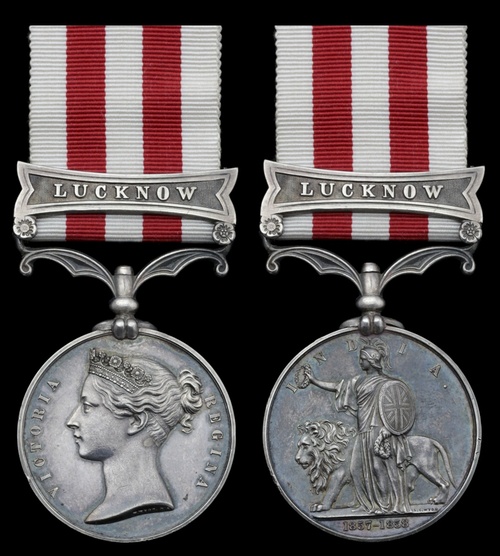
Auction: 22075 - Orders, Decorations and Medals
Lot: 47
The Indian Mutiny medal awarded to Lieutenant G. Swetenham, Royal Engineers, who was wounded during the siege of Lucknow and later Mentioned in Despatches for his good work during the campaign
Indian Mutiny 1857-58, 1 clasp, Lucknow (Lieut G. Swetenham, Royal Engrs), good very fine
George Swetenham was born in India in 1837, son of Edmund and Rose: his father was, at that time, commanding the Sappers & Miners at Delhi and his mother is noted as the daughter of a local zamindar-landowner. After a military education at Woolwich, George was commissioned Lieutenant in the Royal Engineers on 7 April 1856, and immediately found himself on the way to India, arriving at Calcutta with 4th Company Royal Engineers (aboard the S.S. Nubia) in November 1857. Joining Sir Colin Cambell's army he was much involved in subsequent actions, being noted as participating in the battles around La Martiniere College and commanding: "60 R.E. and 50 Punjaubs, under Swetenham and Nutthall...took the Chutur Kotee, threw up a mortar battery on the left of the Padsha Bagh. Corporal Trimble showed much courage...Garret was wounded, also poor Swetenham... (History of the Corps of Royal Engineers, 1889, p.490 refers). His injury incurred on 7 March (a 'slight' musket-ball wound in the left leg) doesn't appear to incapacitated him for too long, however, as he is next noted as taking seven men of his company, and 100 men of the Delhi Pioneers, to destroy one face of the Jellalabad fort outside Lucknow (ibid, p. 497); he later received a well-deserved 'mention' in Major-General Sir James Outram's Despatch in which Major Nicholson R.E. "highly applauds the energy displayed by the officers of that department, vis., Lieutenants Malcolm, Wynne, and Swetenham". (London Gazette 25 May 1858, refers).
After the Mutiny and at the amalgamation of the Indian Corps of Engineers with those of the British Army, Swetenham joined the Indian Public Works Department and rose up through the ranks to become first-grade Executive Engineer by March 1868. Chiefly employed on the construction of military buildings, it is said he was the first to use granite in the building of various cantonments (Minutes of the Proceedings of the Institution of Civil Engineers, Vol. 55, p. 334, 1879, refers).
Elected an Associate of the Institution of Civil Engineers on 23 May 1871, Swetenham died of cholera at Bolarum on 10 July 1878.
Purchased Baldwins, 30 June 1946, for 9/6.
Subject to 20% VAT on Buyer’s Premium. For more information please view Terms and Conditions for Buyers.
Sold for
£1,400




